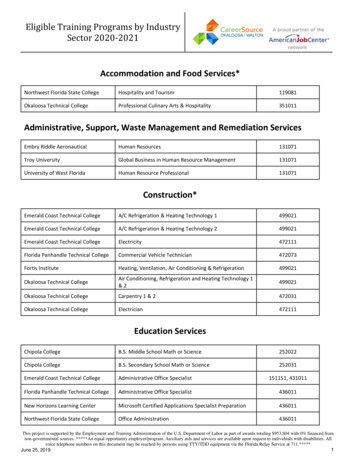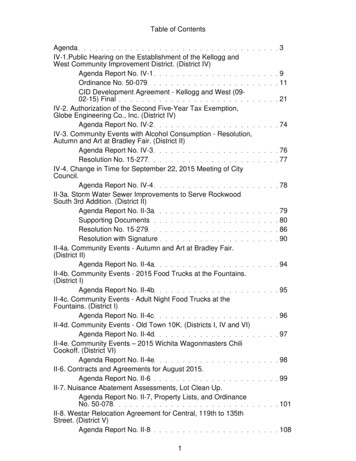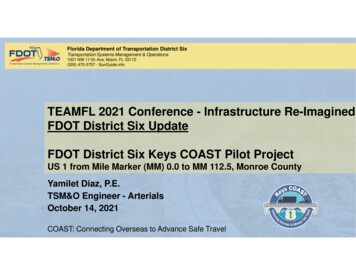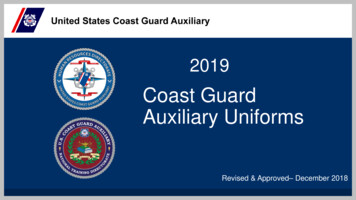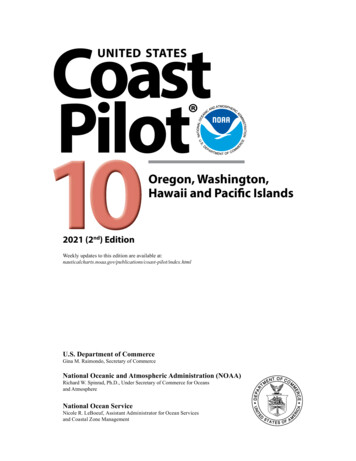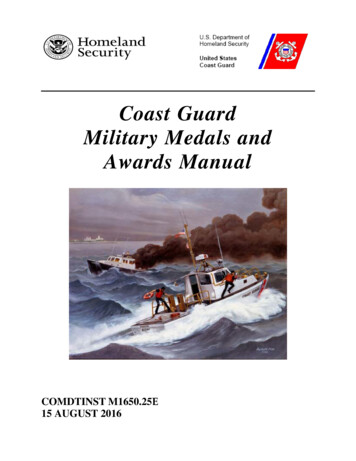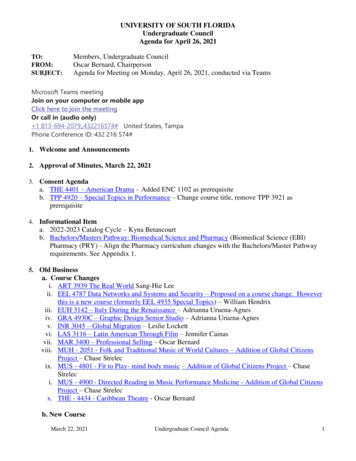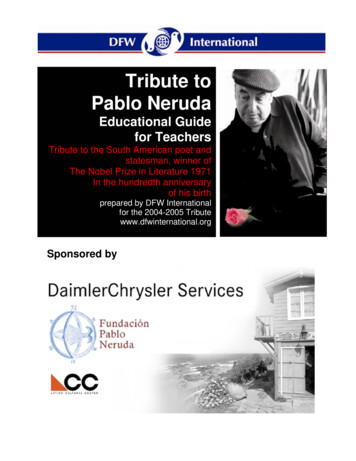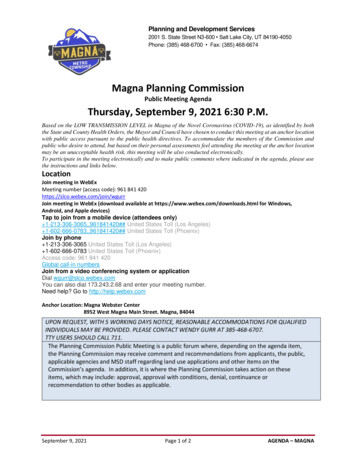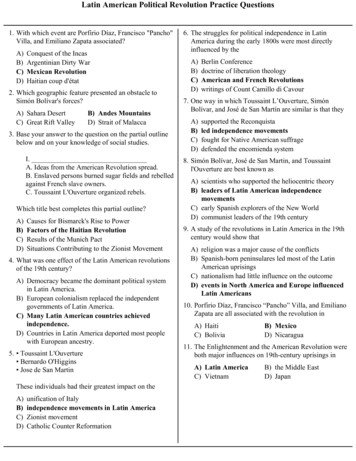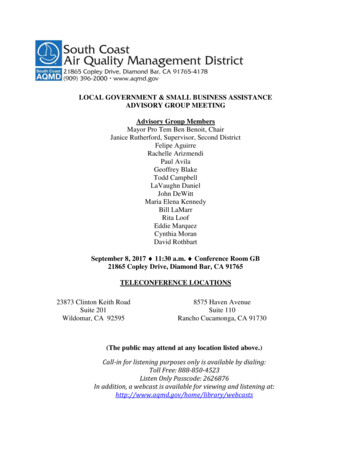
Transcription
LOCAL GOVERNMENT & SMALL BUSINESS ASSISTANCEADVISORY GROUP MEETINGAdvisory Group MembersMayor Pro Tem Ben Benoit, ChairJanice Rutherford, Supervisor, Second DistrictFelipe AguirreRachelle ArizmendiPaul AvilaGeoffrey BlakeTodd CampbellLaVaughn DanielJohn DeWittMaria Elena KennedyBill LaMarrRita LoofEddie MarquezCynthia MoranDavid RothbartSeptember 8, 2017 11:30 a.m. Conference Room GB21865 Copley Drive, Diamond Bar, CA 91765TELECONFERENCE LOCATIONS23873 Clinton Keith RoadSuite 201Wildomar, CA 925958575 Haven AvenueSuite 110Rancho Cucamonga, CA 91730(The public may attend at any location listed above.)Call-in for listening purposes only is available by dialing:Toll Free: 888-850-4523Listen Only Passcode: 2626876In addition, a webcast is available for viewing and listening at:http://www.aqmd.gov/home/library/webcasts
AGENDACALL TO ORDERACTION ITEMS (Items 1 thru 3):1. Call to Order/Opening Remarks(No Motion Required)2.Approval of July 14, 2017 Meeting Minutes(No Motion Required)[Attachment 1]3.Review of Follow-Up/Action ItemsMayor Pro Tem Ben BenoitCommittee ChairDerrick J. Alatorre,Deputy Executive OfficerLegislative, Public Affairs &MediaDerrick J. AlatorreDISCUSSION ITEMS (Items 4 thru 6):4.Summary of Recent Studies of Air Pollution & Health Effects(No Motion Required)Staff will provide a summary of some key recent research studies of airpollution and health effects.5.Update on SCAQMD-Funded Warehouse Truck Trip Study(No Motion Required)Staff will present a summary of the results of this study that was finalizedin October 2016, and some potential uses of the data.6.Summary of Recent Amendment to Rule 1401 – New SourceReview of Toxic Air Contaminants(No Motion Required)Staff will provide a summary of amendments to Rule 1401 which wereadopted on September 1, 2017.Jo Kay GhoshHealth Effects Officer,Planning, Rule Development &Area SourcesIan MacMillan,Planning & Rules Manager,Planning, Rule Development &Area SourcesSusan Nakamura,Asst. Deputy Executive Officer,Planning, Rule Development &Area SourcesWRITTEN REPORT:7.Monthly Report on Small Business Assistance Activities(No Motion Required)Summary of assistance and outreach activities conducted by SCAQMD’sSmall Business Assistance Office for July/August 2017[Attachment 2 - Written Report]All
OTHER MATTERS:8.Other BusinessAny member of this body, or its staff, on his or her own initiative or inresponse to questions posed by the public, may ask a question forclarification, may make a brief announcement or report on his or herown activities, provide a reference to staff regarding factual information,request staff to report back at a subsequent meeting concerning anymatter, or may take action to direct staff to place a matter of business ona future agenda. (Govt. Code Section 54954.2)9.Public Comment PeriodMembers of the public may address this body concerning any agendaitem before or during consideration of that item (Govt. Code Section54954.3(a)). All agendas for regular meetings are posted at DistrictHeadquarters, 21865 Copley Drive, Diamond Bar, California, at least 72hours in advance of a regular meeting. At the end of the regular meetingagenda, an opportunity is also provided for the public to speak on anysubject within the Legislative Committee’s authority. Speakers may belimited to three (3) minutes each.10Next Meeting Date: October 13, 2017 at 11:30 a.m.ADJOURNMENTDocument AvailabilityAll documents (i) constituting non-exempt public records, (ii) relating to an item on an agenda for a regularmeeting, and (iii) having been distributed to at least a majority of the Committee after the agenda is posted, areavailable prior to the meeting for public review at the South Coast Air Quality Management District, PublicInformation Center, 21865 Copley Drive, Diamond Bar, CA 91765.Americans with Disabilities ActThe agenda and documents in the agenda packet will be made available, upon request, in appropriate alternativeformats to assist persons with a disability (Gov’t Code Section 54954.2(a)). Disability-related accommodationswill also be made available to allow participation in the Legislative Committee meeting. Any accommodations mustbe requested as soon as practicable. Requests will be accommodated to the extent feasible. Please contact LoriLangrell at (909) 396-2530 from 7:00 a.m. to 5:30 p.m., Tuesday through Friday, or send the request tollangrell@aqmd.gov.
AGENDA ITEM #2Approval of July 14, 2017 Meeting Minutes[Attachment 1 – Meeting Minutes]
LOCAL GOVERNMENT &SMALL BUSINESS ASSISTANCE ADVISORY GROUPFRIDAY JULY 14, 2017MEETING MINUTESMEMBERS PRESENT:Ben Benoit, Mayor Pro Tem, City of Wildomar and LGSBA Vice ChairmanFelipe AguirrePaul Avila, P.B.A. & AssociatesGeoffrey Blake, Metal Finishers of Southern California/All MetalsJohn DeWitt, JE DeWitt, Inc.Bill LaMarr, California Small Business AllianceRita Loof, RadTech InternationalEddie Marquez, Paramount PetroleumCynthia Moran, Council Member, City of Chino HillsDavid Rothbart, Los Angeles County Sanitation DistrictMEMBERS ABSENT:Janice Rutherford, Supervisor, Second District, San Bernardino CountyRachelle Arizmendi, Mayor Pro Tempore, City of Sierra MadreTodd Campbell, Clean EnergyMaria Elena Kennedy, Kennedy CommunicationsLaVaughn Daniel, DancoENOTHERS PRESENT:Mark Abramowitz, Board Member Consultant (Lyou)David Czmanske, Board Member Consultant (Cacciotti)Andrew Silva, Board Member Consultant (Rutherford)Ruthanne Taylor-Berger, Board Member Consultant (Benoit)SCAQMD STAFF:Fabian Wesson, Assistant Deputy Executive Officer/Public AdvisorNancy Feldman, Principal Deputy District CounselTracy Goss, Planning & Rules ManagerDean Saito, Planning & Rules ManagerPhill Hubbard, AQ Analysis & Compliance SupervisorVan Doan, AQ Inspector IIElaine-Joy Hills, AQ Inspector IILori Langrell, SecretaryAgenda Item #1 - Call to Order/Opening RemarksChair Ben Benoit called the meeting to order at 11:30 a.m.
Agenda Item #2 – Approval of June 9, 2017 Meeting Minutes/Review of Follow-Up/Action ItemsChair Benoit called for approval of the June 9, 2017 meeting minutes.The minutes were approved unanimously.Agenda Item #3 – Follow Up/Action ItemsMs. Lori Langrell indicated the only follow-up was a request by Mr. Geoff Blake to look into reasonswhy he is blocked from receiving emails pertaining to rules, for example Rule 1147 and Rule 1402.Information Management staff will be working with Mr. Blake regarding email delivery issues of rulemail-outs.Agenda Item #4 – Rule 1147: NOx Reductions from Miscellaneous SourcesMr. Tracy Goss provided a summary of recent amendments to Rule 1147.Mr. Paul Avila indicated in the past there were only a handful of manufacturers of burners, many ofwhich have gone bankrupt. Mr. Avila asked what the District’s stance is on those that have gonebankrupt, and what happens if the equipment doesn’t last for 35 years, but only 20. Mr. Goss repliedthat is one of the reasons why the amendments were done. If retrofitting does not work, or is not costeffective, in going through the certification process, there will be a lot of options. As for themanufacturers who are out of business, there is not much we can do about it.Agenda Item #5 – Update on Rule 430Mr. Phill Hubbard provided an overview of Rule 430, breakdown notification requirements and Districtresponse procedures.Mr. Avila asked if language can be included pertaining to a disgruntled employee. Mr. Hubbardresponded that it is not included in the rule.Mr. David Rothbart stated that he noted on the Rule and Control Measure Forecast attachment that Rule430 will be modified per the US EPA. Mr. Rothbart asked if this is to comply with US EPA’s rules,even as 36 states have challenged the policy, and administration has asked for a delay. Mr. Hubbardreplied that the District is addressing all the issues at this time. Mr. Rothbart asked if there is any datefor this, and Mr. Hubbard indicated no.Mr. Bill LaMarr asked if it is true that US EPA never approved Rule 430. Ms. Nancy Feldmanresponded that to the best of her knowledge the State Implementation Plan (SIP) was never approved.Mr. Avila asked if an inspector finds all breakdown criteria has been met and the breakdown results inan odor, if the permittee is still liable for the odor violation. Mr. Hubbard confirmed that they are stillliable for the odor.Agenda Item #6 – Vehicle Scrapping Programs OverviewMr. Dean Saito provided an overview of three vehicle scrapping programs implemented in the SouthCoast basin.-2-
Mr. Blake asked what the federal poverty level is. Mr. Saito indicated that it varies depending on thenumber in the household. For example, 34,000/year at 225% equals 54,000 per year for a family offour.Mr. LaMarr asked regarding the agreement that has been signed, if funding is contingent upon the capand-trade that is before the legislature now. Mr. Saito responded no it preceded it.Mr. Avila asked if a city’s code enforcement has a tow company pick up a car, if SCAQMD monitorsthe tow company on whether they sell the car. Mr. Saito indicated that in this program, the consumerwho owned the car would have to demonstrate that the car was in operation for the previous two years.They can either show two years of registration, two years of paid insurance, or provide repair invoicesfor work done by a licensed technician.Agenda Item #7 –Monthly Report on Small Business Assistance ActivitiesNo comments.Agenda Item #8 - Other BusinessMs. Rita Loof wanted to provide a clarification regarding a comment from the May 12, 2017 meeting.She was not referring to Rule 1130, but was referring to Rule 219. The printing industry has requestedclarification on the new recordkeeping process. The rule does not make any mention of the form. Ms.Loof is requesting a presentation on what the actual form will look like, and a request for outreach ofsame.Action Item: Agendize a presentation regarding Rule 219 recordkeeping.Mr. Paul Avila asked if an overview, a brief one, on cap-and-trade can be presented in the future.Action Item: Agendize a brief overview of cap-and-trade.Ms. Loof commented that the Rule & Control Measure Forecast Rule 1168 (adhesives) is coming up tothe Board in October. She stated that this will have a major impact on small businesses. The definitionof adhesive is anything that is used to attach one surface to another. This could be a huge concern, notonly for recordkeeping rules, but also manufacturers from outside of California bringing it into theDistrict who is liable.Agenda Item #9 - Public CommentChair Benoit asked the student interns in the audience to introduce themselves, what department theywork in, and what school they attend.Mr. Mitchell McMahon asked how many applicants are on the wait list for the EFMP program. Mr.Saito replied that there currently is no wait list.Ms. Ruby Robles asked what model year the car being turned in for replacement has to be for the EFMPprogram. Mr. Saito indicated that any model year 2000 and older is accepted without an emissions test,and model years after 2000 must fail emissions testing to qualify.AdjournmentThe meeting adjourned at 12:19 p.m.-3-
AGENDA ITEM #4Summary of Recent Studies of Air Pollution & Health Effects
Recent Studies ofAir Pollution & Health EffectsSummary of some key research studiesJo Kay Ghosh, Ph.D.Health Effects OfficerSouth Coast Air Quality Management DistrictLGSBA Advisory Group MeetingSeptember 8th , 2017
Existing knowledge,and newer areas of researchUS EPA established as causal PM2.5 Cardiovascular Mortality Ozone Respiratory (many others)Newer areas of research PM-Mortality studies Evaluate lowerexposures Quantify impacts Mechanistic studies Neurological health Metabolic diseases
Air Pollution and Mortality in the MedicarePopulationDi et al. (2017) New England Journal of Medicine Large cohort of 60 million Medicare beneficiaries, 2000 to 2012 PM2.5 and Ozone levelsKey Findings: Increased mortality risk from PM2.5 and Ozone, including at levelsbelow current national standards. For PM2.5, higher risks among men, African Americans, andpeople with low income.
Mortality Studies – Quantifying ImpactGlobal burden of disease studyCohen et al. (2017) The Lancet Evaluated global mortality due to PM2.5 and Ozone PM2.5 was the fifth-ranking mortality risk factor in 2015 PM2·5 exposures: 4.2 million deaths 7.6% of total global deaths Ozone exposures: 254,000 deathsFigure adapted from Cohen et al. (2017) Lancet, Figure 5
Mortality Studies – Quantifying ImpactExcess Morbidity and Mortality in the USCromar et al. (2016) American Thoracic Society (ATS) Compared PM2.5 and Ozone to ATSStandards PM2.5 (annual) ATS standard 11ug/m3 Ozone (8-hour) ATS standard 60 ppb 9,000 excess deaths in the study areasdue to PM2.5 and Ozone above ATSstandards California: 37% of total health impactsFigure adapted from Cromar et al. (2016) ATS, Figure 2Web tool: www.healthoftheair.org
Multi-Ethnic Study ofAtherosclerosis (MESA)Lung cancer survivalEckel et al. (2017) ThoraxKaufman et al. (2016) The Lancet 10-year cohort study Six metropolitan areas in the US(including LA County) 350,000 lung cancer patients,diagnosed 1988-2009 California Long-term exposure to PM2.5, NOX, andblack carbon Residential concentrations of NO2, O3,PM10, PM2.5KEY FINDINGS:KEY FINDINGS: Increased air pollution levels associatedwith accelerated coronary arterycalcification, an indicator ofatherosclerosis progression Air pollution exposures after lung cancerdiagnosis shorten survival, especiallyfor those diagnosed at early stages.
Emerging Evidence: Air Pollution and AutismPrenatal PM exposure: Roberts et al., 2013 Becerra et al., 2013Exposure to PM2.5during the 3rd trimester:increased susceptibility Raz et al., 2015High exposure to trafficpollution during thefirst year of life Volk et al., 2013Stage ofpregnancyand child’sageThree months beforepregnancy to year two Talbott et al., 2015ElevatedAutismRiskProximitytofreewaysIn utero exposure to toxicsfrom traffic and industry: Von Ehrenstein et al., 2014Proximitytoindustry
Emerging Evidence: Cognitive EffectsChildrenAdultsMaternal exposure Negative effects on childhoodreasoning skillsPM2.5- Tonne et al, 2015 Lower IQ scores in children- Jedrychowski, 2015Fine particulates Lower verbal learningperformance Worsened cognitive function- Gatto et al 2014- Vishnevetsky, 2015Traffic-related air pollutants Impaired cognitionYouth exposure Sustained attention decrease- Kicinski, 2015MnManganese Deficits in workingmemory & verbal skills- Bowler et al, 2015
Emerging Evidence: Neurodegenerative DiseasesHigher risk of newly-diagnosed Alzheimer’s DiseaseJung et al, 2015Short-term PM exposure increases the risk of mortality in patients withneurodegenerative diseasesZanobetti et al, 2014Association with Amyotrophic Lateral Sclerosis (ALS) High exposure to diesel exhaust increases riskMalek et al, 2015; Pamphlett & Rikard-Bell, 2013
SummaryNew research links airpollution to neurologicaleffectsDecreases in: Global cognitive functionBowler et al 2015, Gatto et al 2014,Colicino et al 2014 MemoryIncreases risk ofAlzheimer’s DiseaseJung et al, 2015Ailshire & Crimmins, 2014, Sunyer et al 2015 AttentionKicinski et al, 2015Prenatal exposures linked toincreased risk of: AutismVon Ehrenstein et al, 2014 Cognitive function issuesLertxundi et al, 2015Air pollution affects cognition in: Children Adults Elderly persons
TAKE-AWAY POINTSAir pollution continues to have significant health impactsIncreased mortality at levels below currentFederal Standards in: California United States GloballyRecent studies link air pollution toShortened lungFaster progression Neurological effects:Autism,cancer survivalof heart diseaseAlzheimer’s,other effects
AGENDA ITEM #5Update on SCAQMD-Funded Warehouse Truck Trip Study
2002Mira Loma Study Evaluatedimpacts ofwarehousinggrowth Air monitoring Modeling Partnered withRiverside County2005WRCOG GoodNeighborGuidelines Recommendedmitigationstrategies fornew warehouses StakeholderWorking Group2012SCAQMDWarehouse TruckTrip Study Traffic counts Business survey StakeholderWorking Groups2014ITE WarehouseTruck Trip Study Completed inOctober 2016 Compilation ofexisting research SCAQMDco-funded studywith NAIOP2
3
4
5
6
Warehouse TypeOverall RateTruck RateTransload & Short Term Storage (91 sites)1.430.45Cold Storage (9 sites)2.120.84Fulfillment Center (1 site)8.180.72Parcel Hub (1 site)10.634.0ITE 9th Edition (Published 2012)1.680.64(Trips/TSF)Transload and Short-Term Storage Truck RateDaily Truck TripsDaily Overall TripsTransload and Short-Term Storage Overall RateBuilding Square Footage (TSF)Building Square Footage (TSF)(Trips/TSF)Correlationbetweenwarehousesize andtrip ratenot clear7
8
9
10
AGENDA ITEM #6Summary of Recent Amendment to Rule 1401 – New SourceReview of Toxic Air Contaminants
Rule 1401New Source Review ofToxic Air ContaminantsLocal Government and Small Business AssistanceAdvisory Group MeetingSeptember 8, 20171
SCAQMD’s Approachto Reducing Public Risk from Air Toxics Multifaceted RegulatoryPermittingApproachAB 2588 #1 Objective: Protect public health Comprehensive Technology and Science BasedSource-SpecificRules
Who Establishes the Methodology toEstimate Health Risk? The California Office of Environmental Health HazardAssessment (OEHHA) is responsible for developing andupdating risk assessment guidance under the Air Toxics HotSpots program State law requires that health risk assessments required underToxics Hot Spots Program be prepared in accordance withOEHHA Guidelines (Health and Safety Code §44360(b)(2)) OEHHA’s health risk guidelinesare used by all air districts statewide
OEHHA’s RevisedHealth Risk Guidelines The Children’s Environmental Health Protection Act of 1999 (SB25)required susceptibility of infants and children be considered in assessingthe health risks associated with air toxicsOn March 6, 2015 OEHHA approved a revision to the Air Toxics HotSpots Program Guidance Manual for Preparation of Health RiskAssessments (OEHHA Revised Guidelines) Incorporated new studieson childhood sensitivities Incorporated new dataon exposure (e.g. breathingrate and time at home)
OEHHA Revised Risk Guidelines ImpactOn Estimating Cancer RiskResidential / SensitiveReceptor Cancer Risk(Calculated riskvalue 3X’s Higher*)Worker ReceptorCancer RiskNo ChangeRevisedQuantification ofFacility Emissions–(Toxic Emissionshave notincreased)Methodologyfor EstimatingCancer Risk(Childhoodsensitivities andbreathing rates)(Slight Change)*Estimated increase of 3X’sand up to 6X for multipathway
Rule 1401 Cancer Risk Thresholds No permit issued for new and modifiedequipment, unless: 10 in a million with TBACT* (R1401) 1 in a million without TBACT* (R1401) 1 in a million near a school - regardless of TBACT(R1401.1)* TBACT is Toxics Best Available Control Technology
2015 OEHHA GuidelinesImpact on SCAQMD Permits SCAQMD staff reviewed past five years of permitted data(2009 to 2014)Majority of permits issued well below Rule 1401 permittingrisk thresholdsMost source types will not require additional controls to meetcurrent thresholdsJune 2015 amendments to Rule 1401 incorporated 2015OEHHA Guidelines excluded spray booths and gasolinedispensing facilities to: Provide additional time to analyze potential permitting impacts of the2015 OEHHA Guidelines and CARB’s gasoline dispensing emissionfactors and speciation profiles
Recent Amendments to 1401 Require spray booths and gasoline dispensing facilitiesto begin using the proposed SCAQMD Risk AssessmentProcedures (Version 8.1)*, which incorporates: 2015 OEHHA Guidelines Proposed gasoline dispensing emission factors andspeciation profiles Current air dispersion model (AERMOD) and updatedmeteorological data Update the list of toxic air contaminants in Table I ofRule 1401 to be consistent with the current list used byOEHHA8
Analysis of Spray Booths Purpose of analysis was to conduct a moredetailed review of permits issued for spray boothsto better estimate potential permitting impacts withthe 2015 OEHHA GuidelinesSCAQMD staff conducted a detailed review of 327permits issued for spray booths to better identify ifadditional pollution controls are needed Sample size with 95% confidence level /- 5% error (327out of 1,400 permits) Random sampling, every 4th permit9
Summary of Spray Booth Review Analyzed 327 permits (random sampling) out of 1,400permits issued from 2009 – 2014 (includes new andmodified)If SCAQMD Risk Assessment Procedures (Version 8.1)which incorporates the 2015 OEHHA Guidelines are used forspray booths: 87% of spray booth permits, no impact expected12% of spray booth permits, more refined assumptions onmaterial usage or amount of toxic air contaminant in materialformulation would eliminate need for pollution controls 1% of spray booth permits may need to upgrade filters inpollution controls from HEPA to ULPANo Impact AfterFurther Review12%NoImpact87%ImpactNoted1% May need a larger blower (increase cost) Filter costs are similar10
Background for Analysis of GasolineDispensing Facilities In March 2015, SCAQMD staff received new information from CARB regardingspeciation profiles for gasoline dispensing facilitiesAdditional time needed to assess permitting impacts with CARB speciationprofiles with the 2015 OEHHA GuidelinesThe following analysis assesses permitting impacts on gasoline dispensingfacilities when accounting for: Proposed gasoline dispensing emission factors and speciation profiles 2015 OEHHA Guidelines Current air dispersion modeling and updated meteorological data Approximately 3,300 gasoline dispensing facilities11
Gasoline Dispensing Facilities If SCAQMD Risk Assessment Procedures (Version 8.1)which incorporates the 2015 OEHHA Guidelines andrevised emission factors (excluding refueling emissionfactor) are used for new and modified gasoline dispensingfacilities: For 300 permits (random sampling) out of 1,200 permitmodifications between 2009 and 2014 No impact expectedFor all 140 new permits for gasoline dispensing facilities issuedfrom 2009 – 2016 97% of new gasoline dispensing facilities – no impact expectedOne gasoline dispensing facility per year would need to do a morerefined health risk analysis (Tier 4 which includes air dispersionmodeling), accept a lower throughput, or re-orient emissionsources12
Analysis of Updates to Toxic AirContaminants in PAR 1401 Table I of Rule 1401 is being updated toreflect revisions by OEHHANo impacts anticipated Caprolactum – Rule 1141 alreadycontrols emissions by 95% Carbonyl sulfide – Already closelycontrolled in refineries Other compounds added acute healthrisk values Acute risk (new) chronic / cancer risk (current)CAS #New Substances Added105-60-2caprolactum463-58-1carbonyl sulfideCAS #Added Health Risk Values106-99-01,3-butadiene (acute)101-68-8Methylene diphenyl diisocyante (acute)584-84-9toluene-2,4-diisocyanate (acute)91-08-7toluene-2,6-diisocyanate (acute)
SCAQMD ContactsGeneral QuestionsSusan Nakamura, snakamura@aqmd.gov (909) 396-3105Permitting GuidelinesJillian Wong, jwong1@aqmd.gov (909) 396-3176AB2588 Guidelines and Prioritization ProceduresVictoria Moaveni, vmoaveni@aqmd.gov (909) 396-2455Gasoline Dispensing FacilitiesDanny Luong, dluong@aqmd.gov (909) 396-2622William Thompson, WThompson@aqmd.gov (909) 396-2398Rule DevelopmentKalam Cheung, kcheung@aqmd.gov (909) 396-3281Michael Morris, mmorris@aqmd.gov (909) 396-328214
AGENDA ITEM #7Monthly Report on Small Business Assistance Activities[Attachment 2]
Small Business AssistanceReport onJuly & August 2017ActivitiesforLG&SBA Advisory Group Meeting of9/8/2017Services Offered – July Permit Application AssistanceVariance Request AssistanceOn-site ConsultationsFee Review Committee Request 2 Granted (Payment Plan)1 Research (Waive Fee)Clearance Letters Issued9/8/20172640203120July & August 2017 ReportServices Offered – August Permit Application AssistanceVariance Request AssistanceOn-site ConsultationsFee Review Committee Request 2 Granted (Reinstatement; Correct Permit)2 Denied (Reinstatement; Refund Fee)Clearance Letters Issued9/8/2017314084159July & August 2017 Report1
Permit Assistance – July 264 Activities Providing Help with PermitApplications. Examples include:35 Manufacturing Facilities32 General Contractors/Consultants/Architects 30 Offices 26 Auto Body Shops 25 Retail Stores 17 Restaurants 13 Storage & Distribution 6 Fueling Stations July & August 2017 Report9/8/2017Permit Assistance – August 314 Activities Providing Help with PermitApplications. Examples include:43 General Contractors/Consultants/Architects39 Retail Stores 34 Offices 31 Manufacturing Facilities 22 Auto Body Shops 21 Dry Cleaners 19 Restaurants 5 Fueling Stations July & August 2017 Report9/8/2017Activities – July Conducted 20 free on-site consultations Auto Body ShopsContractorsDry CleanersGovernment AgencyManufacturersWood ShopIssued 120 Clearance LettersEvent(s) Attended 9/8/201762nd Assembly Back to School Health & Wellness FairJuly & August 2017 Report2
Activities – August Conducted 8 free on-site consultations Auto Body ShopsDry CleanerGovernment AgenciesManufacturerMedical OfficeApartment ComplexIssued 159 Clearance LettersJuly & August 2017 Report9/8/2017Dry Cleaner Grants Issued(as of 8/2017) Professional Wet Cleaning140 CO2 Machines4 Hydrocarbon (funds expended)488July & August 2017 Report9/8/2017Small Business ActivityJuly 2016 – July 011206Fee 62021132119357498107120587July & August 2017 Report3
Small Business ActivityAugust 2016 – August ee 021132119357498107120159726July & August 2017 Report9/8/2017Small Business ActivityJuly 2017350300Quantity250200Permit AssistanceOn-Site 17May-17Jul-17Month-YearJuly & August 2017 Report9/8/2017Small Business ActivityAugust 2017350300Quantity250200Permit AssistanceOn-Site 17Jun-17Aug-17Month-Year9/8/2017July & August 2017 Report4
INFORMATIONAL ATTACHMENT2017 Attendance Matrix
LGSBA MATRIX FOR YEAR 2017NOMTGNAMENOMTGJan. Feb. Mar. Apr. May Jun. Jul. Aug. Sep. Oct. Nov.111111EE11EEAguirre, Felipe000101Arizmendi, Rachelle----111EAvila, Paul1E1111Blake, Geoffrey011111Campbell, Todd111EEEDaniel, LaVaughn111111DeWitt, John111111Kennedy, Maria Elena100000La Marr, Bill111111Loof, Rita1111E1Marquez, Eddie------111Moran, Cynthia11E1E1Rothbart, David111111Benoit, BenRutherford, Janice0/Absent1/AttendedE/ExcusedDec.
INFORMATIONAL ATTACHMENTOctober 6, 2017 Governing Board Meeting Draft Agenda
8/31/2017 3:40 PMSCAQMD SPECIAL MEETING IN LOS ANGELESDRAFTMEETING, OCTOBER 6, 2017A meeting of the South Coast Air Quality Management District Board will be held at9:00 a.m., in the Emerald Ballroom at the Millennium Biltmore Hotel Los Angeles,506 South Grand Avenue, Los Angeles, California.The agenda and documents in the agenda packet will be made available upon request in appropriatealternative formats to assist persons with a disability. Disability-related accommodations will also be madeavailable to allow participation in the Board meeting. Any accommodations must be requested as soon aspracticable. Requests will be accommodated to the extent feasible. Please telephone the Clerk of theBoards Office at (909) 396-2500 from 7:00 a.m. to 5:30 p.m. Tuesday through Friday.All documents (i) constituting non-exempt public records, (ii) relating to an item on the agenda, and (iii)having been distributed to at least a majority of the Governing Board after the agenda is posted, areavailable prior to the meeting for public review at the South Coast Air Quality Management District Clerk ofthe Boards Office, 21865 Copley Drive, Diamond Bar, CA 91765.Please note: This is a draft agenda and is subject to change.
-2-CALL TO ORDER Pledge of Allegiance Opening Comments:William A. Burke, Ed.D., ChairOther Board MembersWayne Nastri, Executive OfficerStaff/Phone (909) 396-CONSENT CALENDAR (Items 1 through XX)Note: Consent Calendar items held for discussion will be moved to Item No. XX9914. Approve Minutes of September 1, 2017 Board MeetingGarzaro/25009917. Set Public Hearings November 3, 2017 to Consider Adoption ofand/or Amendments to SCAQMD Rules and RegulationsNastri/31319912.Set Public Hearing November 3, 2017 to DetermineThat Proposed Rule 1180 is Exempt from CEQA andAdopt Rule 1180 – Refinery Fenceline and CommunityAir MonitoringProposed Rule 1180 establishes fenceline and community airmonitoring requirements for petroleum refineries. The proposed rulewill require petroleum refineries to install and operate continuous,real-time fenceline and community air monitoring systems to monitora comprehensive list of criteria pollutants and toxic air contaminants.The proposal will require approval of a submitted plan that providesdetailed information about the fenceline and community air monitoringsystems such as siting, wind data collection, maintenanceprocedures, measures in case of failures, auditing, and data reportingmethods. Further, the proposed rule will set-forth requirements forthe plan review process, notifica
Nancy Feldman, Principal Deputy District Counsel Tracy Goss, Planning & Rules Manager . Agenda Item #1 - Call to Order/Opening Remarks Chair Ben Benoit called the meeting to order at 11:30 a.m. Agenda Item #2 - Approval of June 9, 2017 Meeting Minutes/Review of Follow-Up/Action Items Chair Benoit called for approval of the June 9, 2017 .
